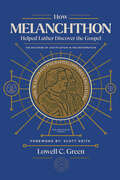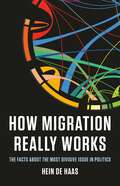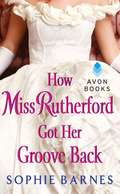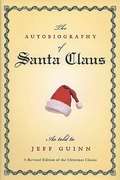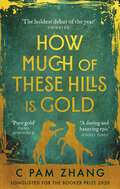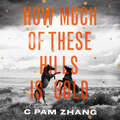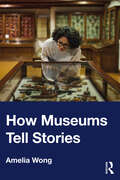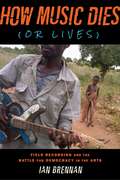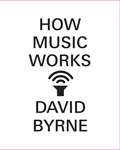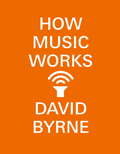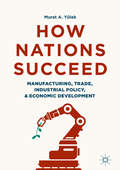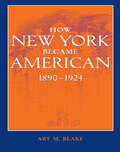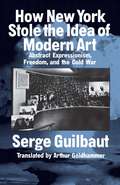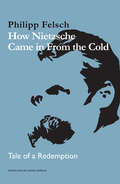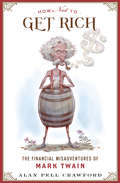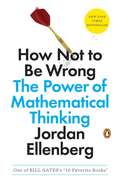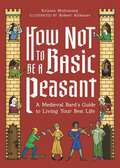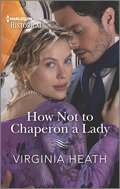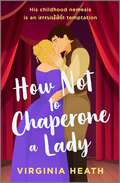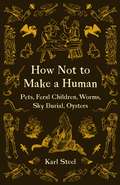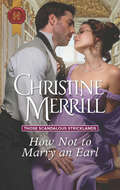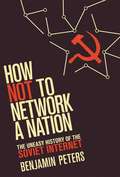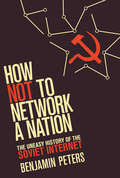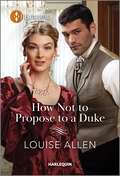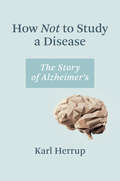- Table View
- List View
How Melanchthon Helped Luther Discover the Gospel: The Doctrine of Justification in the Reformation
by Lowell C GreenThis book is not claiming Melanchthon rediscovered the gospel. That honor belongs to his friend and mentor, Martin Luther. Nevertheless, Dr. Lowell C. Green argues that Melanchthon helped Luther in the task. Dr. Green knew that in choosing the title, How Melanchthon Helped Luther Discover the Gospel, he risked arousing the prejudice of those who look on Melanchthon with suspicion. Green is not blind to Melanchthon's faults; at times, he is critical of him. But, he debunks the myth that when Melanchthon came to Wittenberg in 1518, Luther had already developed his Reformational doctrine. Green shows that Melanchthon brought the tools of humanism to the aid of the emerging agitation. Although maintaining a subordinate role to Luther, Melanchthon helped him repeatedly at the turning points of the Reformation.Green asserts that Melanchthon was the first to speak of the authority of the Bible over the church. In his Baccalaureate Theses of 1519, Melanchthon became the first to articulate the forensic nature of justification. Most surprisingly, Melanchthon helped Luther move from the medieval view of faith as credulitas or adhaesio (adherence) to the Reformational view of faith as fiducia (trust) and assurance of salvation. Luther testified that he learned this from Melanchthon in 1518.As late as 1519, Luther had not yet abandoned the medieval view of grace as an infused substance. Melanchthon again led the way in 1520 when he declared that grace was simply the attitude of God-His favor. In his 1521 Loci Communes Melanchthon not only pointed out that grace is not something in us, but he made the important distinction between "grace" and "the gift of grace" (the Holy Spirit). Luther generously acknowledged the brilliance of Melanchthon's Loci Communes. This and other accolades Luther showered on Melanchthon are an indication of young scholar's influence on the great reformer's central teachings.Lowell C. Green was one of America's foremost Luther scholars, and his body of work continues to inform and shape Reformation studies today. This edition of How Melanchthon Helped Luther Discover the Gospel is the fruition of more than twenty-five years of Luther studies. Dr. Green's central thrust was to challenge the "Young Luther" cult which originated in the early 1900s and gained such a stranglehold on Luther studies in the 1950s and 1960s. In this volume, Green marshals the evidence gathered over a lifetime of study, joining his voice to a choir of scholars who challenge the central thesis of the "Young Luther" movement.After thoroughly demonstrating that Luther's early works contained a medieval or Roman Catholic "analytical justification," Green traces the emergence of the Reformational doctrine and a real break with medieval theology beginning in 1519.Green amply demonstrates that the mature Luther subscribed to and frequently expressed the doctrine of justification in forensic terms so that the glory of our salvation could be ascribed wholly to Christ and for the comfort of conscience against the accusing power of the law.
How Migration Really Works: The Facts About the Most Divisive Issue in Politics
by Hein de HaasAn authoritative guide to global migration that corrects decades of misunderstanding and misguided policy, "defying orthodoxy on all sides of the debate" (Yascha Mounk, author of The Identity Trap). As debates on immigration have reached fever pitch, so has political and media fearmongering. But what are the facts behind the headlines? Drawing on three decades of research, migration expert Hein de Haas destroys the myths that politicians, interest groups, and media spread about immigration. He reveals: Global migration is not at an all-time high Climate change will not lead to mass migration Immigration mainly benefits the wealthy, not workers Border restrictions have paradoxically produced more migration Ultimately, de Haas shows migration not as a problem to be solved, nor as a solution to a problem, but as it really is. This book is an essential guide to one of our most divisive political issues, showing how we can move beyond today&’s deeply polarized debate and make migration work better for everyone.
How Miss Rutherford Got Her Groove Back
by Sophie BarnesEmily Rutherford is having a very bad day. Of course, having the man you've loved forever announce his engagement to your (now very former) best friend will do that. Emily is sure nothing good could possibly come out of this horrid situation. But she lets her sisters-along with Francis Riley, the delectable but brooding Earl of Dunhurst-convince her that a season in London will be just the thing. Now Emily has a choice: sulk in a corner while her sisters enjoy the glitter of the ton . . . or become the belle of the ball, dazzling everyone on an earl's arm. But as Francis helps Emily get back on her feet, she quickly realizes that a childhood crush is nothing compared to the power of true love.
How Mrs. Claus Saved Christmas
by Jeff GuinnIn How Mrs. Claus Saved Christmas, Jeff Guinn combines solid historical fact with glorious legend to deliver another heartwarming holiday book for the whole family. It's 1620 and Mrs. Claus's dear husband is off in the New World planting the seeds of what will become a glorious Christmas tradition. Meanwhile, Mrs. Claus has chosen to stay in England, where the first signs of a dangerous threat to Yuletide cheer are in evidence. The Puritans have gained control of Parliament and appear determined to take all the fun out of Christmas. But Mrs. Claus knows that it's time for serious action when, in 1647, a law is passed by Parliament that actually punishes anyone who celebrates Christmas. Using as its springboard the actual events of a day in 1647 when ten thousand peasants marched through the streets of Canterbury demanding their right to celebrate a beloved holiday, How Mrs. Claus Saved Christmas is rich in historical detail, adventure, and plain ol' Christmas fun.
How Much of These Hills is Gold: Longlisted for the Booker Prize 2020
by C Pam ZhangLONGLISTED FOR THE BOOKER PRIZE 2020LONGLISTED FOR THE RATHBONES FOLIO PRIZE 2021'The boldest debut of the year . . . It is refreshing to discover a new author of such grand scale, singular focus and blistering vision' ObserverAmerica. In the twilight of the Gold Rush, two siblings cross a landscape with a gun in their hands and the body of their father on their backs . . . Ba dies in the night, Ma is already gone. Lucy and Sam, twelve and eleven, are suddenly alone and on the run. With their father's body on their backs, they roam an unforgiving landscape dotted with giant buffalo bones and tiger paw prints, searching for a place to give him a proper burial.How Much of These Hills is Gold is a sweeping adventure tale, an unforgettable sibling story and a remarkable novel about a family bound and divided by its memories.'The 19th-century American West is the setting for C Pam Zhang's impressive debut. Rickety wagons, gambling dens, dusty towns and dodgy outlaws stalk its pages . . . How Much of These Hills is Gold breaks the mould [as a] revisionist immigrant fable of the making of the West . . . a daring and haunting epic' Sunday Times 'A truly gifted writer' Sebastian Barry, two-time Costa Book of the Year winner 'Pure gold' Emma Donoghue, Booker-shortlisted author of Room 'Dazzling' Daisy Johnson, Booker-shortlisted author of Everything Under A GWYNETH PALTROW BOOK CLUB PICK
How Much of These Hills is Gold: ‘A tale of two sisters during the gold rush … beautifully written’ The i, Best Books of the Year
by C Pam ZhangLONGLISTED FOR THE BOOKER PRIZE 2020A BARACK OBAMA BOOK OF THE YEAR 2020America. In the twilight of the Gold Rush, two siblings cross a landscape with a gun in their hands and the body of their father on their backs . . . Ba dies in the night, Ma is already gone. Lucy and Sam, twelve and eleven, are suddenly alone and on the run. With their father's body on their backs, they roam an unforgiving landscape dotted with giant buffalo bones and tiger paw prints, searching for a place to give him a proper burial.How Much of These Hills is Gold is a sweeping adventure tale, an unforgettable sibling story and a remarkable novel about a family bound and divided by its memories.'A daring and haunting epic' SUNDAY TIMES'A unique reimagining of the American West adventure' THE TIMES'A fierce, feminist Western' DAILY MAIL'Remarkable' HARPER'S BAZAAR'Reminiscent of both Cormac McCarthy and Toni Morrison' IRISH TIMES'C Pam Zhang's arresting, beautiful first novel is filled with myths of her own making as well as sorrows and joys' NEW YORK TIMESA GWYNETH PALTROW BOOK CLUB PICK
How Museums Tell Stories
by Amelia WongHow Museums Tell Stories explains how museums “work” as a form of media that narrates stories intentionally and unintentionally. Story—in life and in museums—is a phenomenon that emerges as people perceive, represent, and interpret the qualities of tellability and narrativity in relation to stimuli. Tellability is noteworthiness: it attracts our attention. Narrativity is a set of elements that enables us to perceive a story is being or could be told. The book discusses how and why these qualities are so present in museums, and how they enable physical institutions to tell stories in many forms, at many scales, in many styles of representation, and to varying degrees. Drawing on conceptions of narrative from literary theory, film, psychology, and cognitive science, Wong offers a shared vocabulary for understanding and analyzing how story manifests in museums at the level of objects, collections, exhibitions, and space.How Museums Tell Stories will be essential reading for researchers and students interested in how and why museums engage audiences, as well as museum and cultural heritage practitioners seeking concepts and analytical tools for approaching and evaluating their work more critically and conscientiously.
How Music Dies (or Lives): Field Recording and the Battle for Democracy in the Arts
by Ian BrennanAll recordings document life, arising from a specific time and place, and if that place is artificial, the results will be as well. Culled from a lifetime of learning through failure and designed to provoke thought and inspiration for artists in every medium, How Music Dies (or Lives) is a virtual how-to manual for those on a quest for authenticity in an age of airbrushed and Auto-Tuned so-called "artists. ” Author and Grammy-winning producer Ian Brennan chronicles his own journeys to find new and ancient sounds, textured voices, and nonmalleable songs, and he presents readers with an intricate look at our technological society. His concise prose covers topics such as: *The damages of colonization in generalizing distinctive variations *The need for imperfection *The gaps between manufacturing and invention *The saturation of music in everyday life This guide serves those who ask themselves, "What’s wrong with our culture?” Along with possible answers are lessons in using the microphone as a telescope, hearing the earth as an echo, and appreciating the value of democratizing voices.
How Music Works
by David ByrneHow Music Works is David Byrne's remarkable and buoyant celebration of a subject he has spent a lifetime thinking about. In it he explores how profoundly music is shaped by its time and place, and he explains how the advent of recording technology in the twentieth century forever changed our relationship to playing, performing, and listening to music.Acting as historian and anthropologist, raconteur and social scientist, he searches for patterns-and shows how those patterns have affected his own work over the years with Talking Heads and his many collaborators, from Brian Eno to Caetano Veloso. Byrne sees music as part of a larger, almost Darwinian pattern of adaptations and responses to its cultural and physical context. His range is panoptic, taking us from Wagnerian opera houses to African villages, from his earliest high school reel-to-reel recordings to his latest work in a home music studio (and all the big studios in between).Touching on the joy, the physics, and even the business of making music, How Music Works is a brainy, irresistible adventure and an impassioned argument about music's liberating, life-affirming power.
How Music Works
by David Byrne*Updated with a new chapter on digital curation*How Music Works is David Byrne’s incisive and enthusiastic look at the musical art form, from its very inceptions to the influences that shape it, whether acoustical, economic, social or technological. Utilizing his incomparable career and inspired collaborations with Talking Heads, Brian Eno, and many others, Byrne taps deeply into his lifetime of knowledge to explore the panoptic elements of music, how it shapes the human experience, and reveals the impetus behind how we create, consume, distribute, and enjoy the songs, symphonies, and rhythms that provide the backbeat of life. Byrne’s magnum opus uncovers ever-new and thrilling realizations about the redemptive liberation that music brings us all.
How Nations Succeed: Manufacturing, Trade, Industrial Policy, and Economic Development
by Murat A. YülekThis book assesses developmental experience in different countries as well as British expansion following the industrial revolution from a developmental perspective. It explains why some nations are rich and others are poor, and discusses how manufacturing made economies flourish and spur economic development. It explains how today’s governments can design and implement industrial policy, and how they can determine economically strategic sectors to break out of Low and Middle Income Traps.Closely linked to global trade and (im)balances, industrialization was never an accident. Industrialization explains how some countries experience export-led growth and others import-led slowdowns. Many confuse industrialization with the construction of factory buildings rather than a capacity and skill building process through certain stages. Industrial policy helps countries advance through those stages. Explaining technical concepts in understandable terms, the book discusses the capacity and limits of the developmental state in industrialization and in general in economic development, demonstrating how picking-the-winner type focused industrial policy has worked in different countries. It also discusses how industrial policy and science, technology and innovation policies should be sequenced for best results.
How New York Became American, 1890–1924
by Art M. BlakeOriginally published in 2006. For many Americans at the turn of the twentieth century and into the 1920s, the city of New York conjured dark images of crime, poverty, and the desperation of crowded immigrants. In How New York Became American, 1890–1924, Art M. Blake explores how advertising professionals and savvy business leaders "reinvented" the city, creating a brand image of New York that capitalized on the trend toward pleasure travel. Blake examines the ways in which these early boosters built on the attention drawn to the city and its exotic populations to craft an image of New York City as America writ urban—a place where the arts flourished, diverse peoples lived together boisterously but peacefully, and where one could enjoy a visit. Drawing on a wide range of textual and visual primary sources, Blake guides the reader through New York's many civic identities, from the first generation of New York skyscrapers and their role in "Americanizing" the city to the promotion of Midtown as the city's definitive public face. His study ranges from the late 1890s into the early twentieth century, when the United States suddenly emerged as an imperial power, and the nation's industry, commerce, and culture stood poised to challenge Europe's global dominance. New York, the nation's largest city, became the de facto capital of American culture. Social reformers and tourism boosters, keen to see America's cities rival those of France or Britain, jockeyed for financial and popular support. Blake weaves a compelling story of a city's struggle for metropolitan and national status and its place in the national imagination.
How New York Stole the Idea of Modern Art: Abstract Expressionism, Freedom, And The Cold War
by Serge Guilbaut"A provocative interpretation of the political and cultural history of the early cold war years. . . . By insisting that art, even art of the avant-garde, is part of the general culture, not autonomous or above it, he forces us to think differently not only about art and art history but about society itself."—New York Times Book Review
How Nietzsche Came in From the Cold: Tale of a Redemption
by Philipp FelschNietzsche’s reputation, like much of Europe, lay in ruins in 1945. Giving a platform to a philosopher venerated by the Nazis was not an attractive prospect for Germans eager to cast off Hitler’s shadow. It was only when two ambitious antifascist Italians, Giorgio Colli and Mazzino Montinari, began to comb through the archives that anyone warmed to the idea of rehabilitating Nietzsche as a major European philosopher. Their goal was to interpret Nietzsche’s writings in a new way and free them from the posthumous falsification of his work. The problem was that 10,000 barely legible pages were housed behind the Iron Curtain in the German Democratic Republic, where Nietzsche had been officially designated an enemy of the state. In 1961, Montinari moved from Tuscany to the home of actually existing socialism to decode the “real” Nietzsche under the watchful eyes of the Stasi. But he and Colli would soon realize that the French philosophers making use of their edition were questioning the idea of the authentic text and of truth itself. Felsch retraces the journey of the two Italian editors and their edition, telling a gripping and unlikely story of how one of Europe’s most controversial philosophers was resurrected from the baleful clutch of the Nazis and transformed into an icon of postmodern thought.
How Not To Get Rich: The Financial Misadventures of Mark Twain
by Alan Pell CrawfordA Wealthmanagement.com Best Business Book of 2017 An uproarious account of Mark Twain&’s endless attempts to strike it rich, all of which served only to empty his pockets Mark Twain&’s lifetime spans America&’s era of greatest economic growth. And Twain was an active, even giddy, participant in all the great booms and busts of his time, launching himself into one harebrained get-rich scheme after another. But far from striking it rich, the man who coined the term &“Gilded Age&” failed with comical regularity to join the ranks of plutocrats who made this period in America notorious for its wealth and excess. Instead, Twain&’s mining firm failed, despite striking real silver. He ended up somehow owing money over his 70,000 acres of inherited land. And his plan to market the mysteriously energizing coca leaves from the Amazon fizzled when no ships would sail to South America. Undaunted, Twain poured his money into the latest newfangled inventions of his time, all of which failed miserably. In Crawford&’s hilarious telling, the familiar image of Twain takes on a new and surprising dimension. Twain&’s story of financial optimism and perseverance is a kind of cracked-mirror history of American business itself—in its grandest cockeyed manifestations, its most comical lows, and its determined refusal to ever give up.
How Not to Be Wrong: The Power of Mathematical Thinking
by Jordan Ellenberg<P>The Freakonomics of math—a math-world superstar unveils the hidden beauty and logic of the world and puts its power in our handsThe math we learn in school can seem like a dull set of rules, laid down by the ancients and not to be questioned. In How Not to Be Wrong, Jordan Ellenberg shows us how terribly limiting this view is: Math isn’t confined to abstract incidents that never occur in real life, but rather touches everything we do—the whole world is shot through with it. <P>Math allows us to see the hidden structures underneath the messy and chaotic surface of our world. It’s a science of not being wrong, hammered out by centuries of hard work and argument. Armed with the tools of mathematics, we can see through to the true meaning of information we take for granted: How early should you get to the airport? What does “public opinion” really represent? Why do tall parents have shorter children? Who really won Florida in 2000? And how likely are you, really, to develop cancer? <P>How Not to Be Wrong presents the surprising revelations behind all of these questions and many more, using the mathematician’s method of analyzing life and exposing the hard-won insights of the academic community to the layman—minus the jargon. Ellenberg chases mathematical threads through a vast range of time and space, from the everyday to the cosmic, encountering, among other things, baseball, Reaganomics, daring lottery schemes, Voltaire, the replicability crisis in psychology, Italian Renaissance painting, artificial languages, the development of non-Euclidean geometry, the coming obesity apocalypse, Antonin Scalia’s views on crime and punishment, the psychology of slime molds, what Facebook can and can’t figure out about you, and the existence of God. <P>Ellenberg pulls from history as well as from the latest theoretical developments to provide those not trained in math with the knowledge they need. Math, as Ellenberg says, is “an atomic-powered prosthesis that you attach to your common sense, vastly multiplying its reach and strength.” With the tools of mathematics in hand, you can understand the world in a deeper, more meaningful way. How Not to Be Wrong will show you how. <P><b>A New York Times Bestseller</b>
How Not to Be a Basic Peasant: A Medieval Bard's Guide to Living Your Best Life
by Kristen MulrooneyHark Peasants! Let this Bard guide you on the journey to becoming a better version of your peasant self. Imagine if the Middle Ages had its own set of influencers and life coaches. Their collected wisdom would produce this very guide. Here, the ultimate Bard takes readers on a self-improvement journey—with lessons that any peasant can pick up and instantly start implementing into their lives. Examples include: How not to make a fool of thyself at the local tavern How to make a scene at a jousting tournament to stay relevant How to make your tiny home into a pleasant place to reside (spoiler: it involves sweeping out the rats) What not to wear (is chainmail in or out?) And what to do in case of a bear chase Including helpful and insightful illustrations inspired by medieval art, this handy guide will keep you become just slightly better than your peers, even if you may never achieve royalty status.
How Not to Chaperon a Lady: A sexy, funny Regency romance (The Talk of the Beau Monde #3)
by Virginia HeathHis childhood nemesis……is the woman he can&’t resist! Chaperoning Charity Brookes while she&’s on a singing tour should be easy for Griffith Philpot—he&’s spent his whole life sparring with her over her flighty ways! But as he discovers that she&’s much more than the impetuous girl he thought he knew, a passion ignites between them… Sharing a steamy kiss leaves him torn—he&’s supposed to be responsible for guarding her virtue!From Harlequin Historical: Your romantic escape to the past.The Talk of the Beau MondeBook 1: The Viscount's Unconventional LadyBook 2: The Marquess Next DoorBook 3: How Not to Chaperon a Lady
How Not to Chaperone a Lady: A Steamy Historical Romance Book (The Talk of the Beau Monde)
by Virginia HeathHis childhood nemesis… …is the woman he can&’t resist! Chaperoning Charity Brookes while she&’s on a singing tour should be easy for Griffith Philpot—he&’s spent his whole life sparring with her over her flighty ways! But as he discovers that she&’s much more than the impetuous girl he thought he knew, a passion ignites between them… Sharing a steamy kiss leaves him torn—he&’s supposed to be responsible for guarding her virtue! Previously published Discover all 3 charming titles in The Talk of the Beau Monde collection: The Viscount&’s Unconventional Lady The Marquess Next Door How Not to Chaperone a Lady
How Not to Make a Human: Pets, Feral Children, Worms, Sky Burial, Oysters
by Karl SteelFrom pet keeping to sky burials, a posthuman and ecocritical interrogation of and challenge to human particularity in medieval texts Mainstream medieval thought, like much of mainstream modern thought, habitually argued that because humans alone had language, reason, and immortal souls, all other life was simply theirs for the taking. But outside this scholarly consensus teemed a host of other ways to imagine the shared worlds of humans and nonhumans. How Not to Make a Human engages with these nonsystematic practices and thought to challenge both human particularity and the notion that agency, free will, and rationality are the defining characteristics of being human.Recuperating the Middle Ages as a lost opportunity for decentering humanity, Karl Steel provides a posthuman and ecocritical interrogation of a wide range of medieval texts. Exploring such diverse topics as medieval pet keeping, stories of feral and isolated children, the ecological implications of funeral practices, and the &“bare life&” of oysters from a variety of disanthropic perspectives, Steel furnishes contemporary posthumanists with overlooked cultural models to challenge human and other supremacies at their roots. By collecting beliefs and practices outside the mainstream of medieval thought, How Not to Make a Human connects contemporary concerns with ecology, animal life, and rethinkings of what it means to be human to uncanny materials that emphasize matters of death, violence, edibility, and vulnerability.
How Not to Marry an Earl (Those Scandalous Stricklands #2)
by Christine MerrillShe much prefers an American stranger over the earl she’s meant to marry—but a surprise awaits . . .To escape marriage to the newly inherited Earl of Comstock, bookish Charity, the plainest of the Strickland sisters, must find her family’s missing diamonds.She meets her match in an intellectual stranger auditing the estate . . . not knowing he is Lord Comstock himself!With him, Charity feels different—even desirable! But will seizing one night of passion bind her to the very man she’s determined to avoid?Praise for the romance of Christine Merrill“Readers will enjoy the strong characters, swift pace, lively wit and the wickedly fun escapades that stubborn lovers can get into.” —RT Book Reviews
How Not to Network a Nation: The Uneasy History of the Soviet Internet
by Benjamin PetersBetween 1959 and 1989, Soviet scientists and officials made numerous attempts to network their nation -- to construct a nationwide computer network. None of these attempts succeeded, and the enterprise had been abandoned by the time the Soviet Union fell apart. Meanwhile, ARPANET, the American precursor to the Internet, went online in 1969. Why did the Soviet network, with top-level scientists and patriotic incentives, fail while the American network succeeded? In How Not to Network a Nation, Benjamin Peters reverses the usual cold war dualities and argues that the American ARPANET took shape thanks to well-managed state subsidies and collaborative research environments and the Soviet network projects stumbled because of unregulated competition among self-interested institutions, bureaucrats, and others. The capitalists behaved like socialists while the socialists behaved like capitalists. After examining the midcentury rise of cybernetics, the science of self-governing systems, and the emergence in the Soviet Union of economic cybernetics, Peters complicates this uneasy role reversal while chronicling the various Soviet attempts to build a "unified information network." Drawing on previously unknown archival and historical materials, he focuses on the final, and most ambitious of these projects, the All-State Automated System of Management (OGAS), and its principal promoter, Viktor M. Glushkov. Peters describes the rise and fall of OGAS -- its theoretical and practical reach, its vision of a national economy managed by network, the bureaucratic obstacles it encountered, and the institutional stalemate that killed it. Finally, he considers the implications of the Soviet experience for today's networked world.
How Not to Network a Nation: The Uneasy History of the Soviet Internet (Information Policy)
by Benjamin PetersHow, despite thirty years of effort, Soviet attempts to build a national computer network were undone by socialists who seemed to behave like capitalists.Between 1959 and 1989, Soviet scientists and officials made numerous attempts to network their nation—to construct a nationwide computer network. None of these attempts succeeded, and the enterprise had been abandoned by the time the Soviet Union fell apart. Meanwhile, ARPANET, the American precursor to the Internet, went online in 1969. Why did the Soviet network, with top-level scientists and patriotic incentives, fail while the American network succeeded? In How Not to Network a Nation, Benjamin Peters reverses the usual cold war dualities and argues that the American ARPANET took shape thanks to well-managed state subsidies and collaborative research environments and the Soviet network projects stumbled because of unregulated competition among self-interested institutions, bureaucrats, and others. The capitalists behaved like socialists while the socialists behaved like capitalists. After examining the midcentury rise of cybernetics, the science of self-governing systems, and the emergence in the Soviet Union of economic cybernetics, Peters complicates this uneasy role reversal while chronicling the various Soviet attempts to build a “unified information network.” Drawing on previously unknown archival and historical materials, he focuses on the final, and most ambitious of these projects, the All-State Automated System of Management (OGAS), and its principal promoter, Viktor M. Glushkov. Peters describes the rise and fall of OGAS—its theoretical and practical reach, its vision of a national economy managed by network, the bureaucratic obstacles it encountered, and the institutional stalemate that killed it. Finally, he considers the implications of the Soviet experience for today's networked world.
How Not to Propose to a Duke (A Season of Celebration #1)
by Louise AllenIn celebration of Harlequin&’s 75th year, we bring you A Season of Celebration! Beginning with this captivating Regency romance…Miss Danby&’s daring proposition for the duke First, wealthy ironmaster&’s daughter Jessica Danby needs a titled husband. So, upon learning that Alexander, the Duke of Malvern, needs a rich wife, she makes a convenient proposal… Next, her impetuous marriage offer is swiftly rejected by Alex, who wants to marry for love! Now Jessica accepts his help in finding another suitor. But as they spend the Season by each other&’s side, she realizes that their unlikely friendship is becoming something more thrilling!From Harlequin Historical: Your romantic escape to the past.A Season of CelebrationBook 1: How Not to Propose to a Duke by Louise AllenBook 2: Wed in Haste to the Duke by Sarah MalloryBook 3: The Kiss That Made Her Countess by Laura Martin
How Not to Study a Disease: The Story of Alzheimer's
by Karl HerrupAn authority on Alzheimer's disease offers a history of past failures and a roadmap that points us in a new direction in our journey to a cure.For decades, some of our best and brightest medical scientists have dedicated themselves to finding a cure for Alzheimer's disease. What happened? Where is the cure? The biggest breakthroughs occurred twenty-five years ago, with little progress since. In How Not to Study a Disease, neurobiologist Karl Herrup explains why the Alzheimer's discoveries of the 1990s didn't bear fruit and maps a direction for future research. Herrup describes the research, explains what's taking so long, and offers an approach for resetting future research.Herrup offers a unique insider's perspective, describing the red flags that science ignored in the rush to find a cure. He is unsparing in calling out the stubbornness, greed, and bad advice that has hamstrung the field, but his final message is a largely optimistic one. Herrup presents a new and sweeping vision of the field that includes a redefinition of the disease and a fresh conceptualization of aging and dementia that asks us to imagine the brain as a series of interconnected "neighborhoods." He calls for changes in virtually every aspect of the Alzheimer's disease research effort, from the drug development process, to the mechanisms of support for basic research, to the often-overlooked role of the scientific media, and more. With How Not to Study a Disease, Herrup provides a roadmap that points us in a new direction in our journey to a cure for Alzheimer's.
